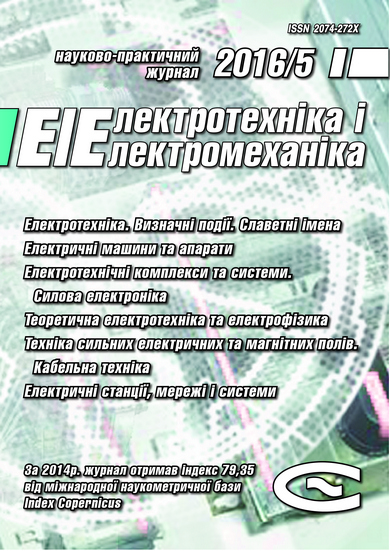STATISTICAL PROCEDURES FOR TWO-SIDED LIMIT OF A CONTROLLED PARAMETER IN THE PROCESS OF PRODUCTION OF CABLE AND WIRE PRODUCTS
DOI:
https://doi.org/10.20998/2074-272X.2016.5.07Keywords:
enameled wire, double polyimide insulation, control card, maximum probability of the parameter exit for the regulatory limitAbstract
Purpose. To consider issues of statistical control in the process of mass production of cable and wire products on the example of enameled wire. To analyze the results of direct control of the diameter of the wire in two-layer polyimide insulation in a continuous technological cycle. To submit to the control map of maximum probability of the exit diameter outside a specific range. To analyze the conditions under which maximum sensitivity of process control. Methodology. Study of the sensitivity of the control map of maximum probability of the exit option for regulatory of limit in the field deviations of the centered parameter close to zero. The existence of stable trends in the change of a controlled parameter can reduce the sensitivity of punishment to instability of the process. Results. To achieve maximum sensitivity of control of the technological frontier should be selected on the basis of the achieved level of the average value of the parameter and its statistical scattering. Process boundaries must be changed in accordance with the achieved level of the average value of the parameter and its statistical scattering. Such a change may serve as a quantitative indicator of trends in the increase or decrease in the reliability of the technological system. Originality. In particular the tasks of current control using engineering tolerances for controlled parameter are impractical. Control on Pmax should be directed to the exception of manufacturing, the parameters of which extend beyond the technical tolerances. Practical value. The exception is the manufacture of bulk cable products, the parameters of which extend beyond the technical tolerances.References
1. Shchebeniuk L.A., Golik O.V. Matematychni osnovy nadiynosti izolyatsiyi elektroobladnannya [Mathematical foundations of the reliability of electrical insulation]. Kharkiv, NTU «KhPI» Publ., 2003. 102 p. (Ukr).
2. Kuznetsov V.P. Interval'nye statisticheskie modeli [Interval statistical models]. Moscow, Radio i sviaz' Publ., 1991. 352 p. (Rus).
3. Karpushenko V.P., Shchebeniuk L.A., Antonets Y.O., Naumenko O.A. Control card – instrument of quality of cable products. Power cables of low and medium voltage. Design, technology, quality. Kharkiv, Region-Inform Publ., 2000. pp. 270-289. (Ukr).
4. Shchebeniuk L.A., Golik O.V. A method of constructing control charts the probability of an exit sign beyond the regulatory limit. Bulletin of Kharkiv State Polytechnic University, 2000, no.127, pp. 35-38. (Rus).
5. Golik O.V. Metod operativnogo kontrolia parametrov dvukhsloinoi poliimidnoi izoliatsii emal'provoda v protsesse proizvodstva. Diss. cand. techn. nauk [Method of controlling parameters of a two-layer polyimide insulation enameled wire in the production process. Cand. tech. sci. diss.]. Kharkov, 2009, 168 p. (Rus).
Downloads
Published
How to Cite
Issue
Section
License
Copyright (c) 2016 O. V. Golik

This work is licensed under a Creative Commons Attribution-NonCommercial 4.0 International License.
Authors who publish with this journal agree to the following terms:
1. Authors retain copyright and grant the journal right of first publication with the work simultaneously licensed under a Creative Commons Attribution License that allows others to share the work with an acknowledgement of the work's authorship and initial publication in this journal.
2. Authors are able to enter into separate, additional contractual arrangements for the non-exclusive distribution of the journal's published version of the work (e.g., post it to an institutional repository or publish it in a book), with an acknowledgement of its initial publication in this journal.
3. Authors are permitted and encouraged to post their work online (e.g., in institutional repositories or on their website) prior to and during the submission process, as it can lead to productive exchanges, as well as earlier and greater citation of published work.





